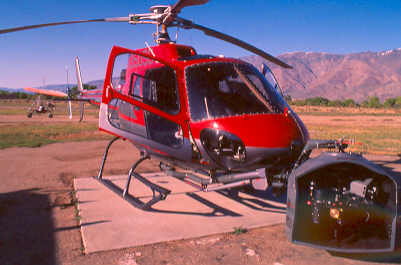 |
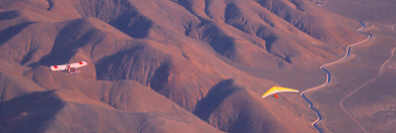 |
Filming Hang Gliding in Owens Valley
© John Heiney 2002
I am shooting air-to-air photos of Howard Hall and John Dunham thermaling up on a beautiful spring day at Horseshoe Meadows. The odd part is, I do not need to worry about where my lift is coming from. In fact, I do not need to pay attention to the flying at all. I am in the back seat of a helicopter piloted by Jim Gavin (Hollywood’s premier rotor and fixed-wing camera and stunt pilot). In the left front seat is Ron Goodman operating the Spacecam® computer-controlled, gyro-stabilized, remote- controlled camera system, which has revolutionized helicopter filming.
 |
 |
Hang Gliding is making a rare appearance in a new IMAX film. The movie is called “Coral Reef Adventure” from Director Greg MacGillivray, and it will be in IMAX theaters starting February 14. How does hang gliding fit into a film about coral reefs, you ask? The film is an underwater adventure story that calls attention to the beautiful yet seriously endangered coral reefs of the world. It follows the 10-month expedition of Howard and his wife Michele on a mission to film and document the reefs of the South Pacific.
If you wish to inspire people to react to a problem, it helps to enchant them with fantastic entertainment while you persuade them with scientific reasoning. The hope is that viewers will be thinking of how they can help play a role in helping coral reefs as they leave the theater. Images of human beings flying on hang gliders is part of the entertainment, and it helps establish Howard’s character. It is also perhaps a gentle subliminal suggestion regarding non-polluting recreation.
The average IMAX film is 45 minutes long. Viewers would feel somewhat water-logged after being “under water” for 45 minutes. A completely different activity on or above the surface becomes a welcome diversion giving the audience a chance to “catch their breath”. Other diversions that were filmed include surfing lessons, whitewater kayaking, kids snorkeling with Jean-Michel Cousteau, and filming from an ultralight piloted by John Dunham.
Generally these diversionary segments are very short in duration. If a 30-second segment of hang gliding seems hardly enough to motivate you toward the theater I assure you that you will not be disappointed by the rest of this film. Judging by the footage I have seen, even the most die-hard sky freaks will be blown away by the spectacular shots of sea life, underwater scenics and the cool shots of cross-country “liquid flying”.
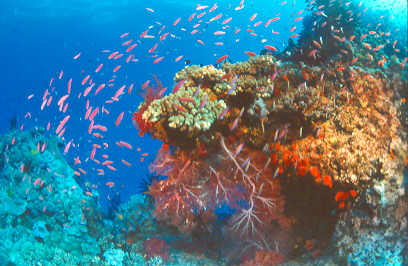 |
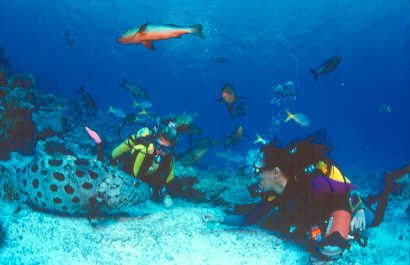 |
Greg MacGillivray’s company, MacGillivray Freeman Films has been making movies and filming aerial scenes for Hollywood movies for over 30 years. Greg was an avid surfer and started his film-making career making surf films. Greg’s film “Five Summer Stories” is one of the most popular surf movies of all time. Greg’s first IMAX film, “To Fly” featuring Bob Wills hang gliding in Hawaii is considered the most popular IMAX film in history. Greg’s recent film “Everest” is possibly the most important IMAX film ever and a cinematic triumph.
Initially I was hired to function as safety coordinator between the hang glider pilots and the. helicopter pilot. I have a good deal of experience flying hang gliders around helicopters and, believe it or not, towing behind helicopters. When Howard learned that he would be flying with a camera helicopter he took the logical step of requesting the benefit of my understanding of helicopter dangers.
When I heard that the producer wanted a “mounted shot” my interest was aroused. My specialty is camera mounts on hang gliders. The idea of mounting an IMAX camera on a hang glider was a daunting but intriguing challenge. It had not been done before. A normal IMAX camera weighs around a hundred pounds. I was aware that MacGillivray Freeman Films has a smaller camera just for such situations. I had heard about it years earlier during another IMAX project. I was disappointed that I did not get to use it then, but this time I would get my wish.
The camera is called the W-14, and it was developed by Jim Williams and Jack Tankard for MacGillivray Freeman Films. It weighs only 35 pounds. Only? I never thought I would be saying “only 35 pounds” in reference to a camera to be mounted on a hang glider. Everything is relative. Even though the weight was barely low enough to consider flying with, there were other problems.
The W-14 is a big, ugly box. Beautiful to a photography enthusiast, but ugly to the relative wind. But the added drag was nothing compared to the position that Greg wanted. It was not my first choice for hanging nearly forty pounds of extra weight. But, when the producer said “here is where I want it”, I just said “I think I can do that”.
The camera position would be near the rear of the keel about 2 feet to the left and two feet down. I was not at all sure it could be done, but I chose to look at it as a challenge. I was not so concerned about my safety because I was intending to conduct progressive “dead-weight” tests starting with twenty pounds on the rear of the keel (counter-balanced in the front of course). Torrey Pines in the Spring would be perfect for these tests.
My real concern was for the safety of the camera. In its chosen position it would be subject to possible ground- contact even on a good landing, which I did not expect to have. I knew that with the camera, battery and counterweights the glider would be weighing more than 150 pounds.
Brad Kushner had let me take a hop on his new T-2 tandem glider from North Wing Design. It was a very nicely-flying big glider. When this mount job came up, I knew which wing I wanted to use to carry the weight. Film production coordinator Anne-Marie Hammers ordered one in the same colors as Howard’s Fusion. For the mount shot the T-2 looked close enough and would be much less death- defying.
I started by clamping twenty pounds of dead weight at the rear of the keel and twenty at the nose. Obviously this would significantly increase the pitch moment-of-inertia. A test flight confirmed that the glider felt dampened in pitch, but it flew quite well.
Later I flew with 35 pounds at the rear, counterweighted on the front. The glider was still plenty controllable. This flight gave me the confidence to proceed with designing the mount system. Flying with extra weight aligned with the keel was predictably easy. Flying with this much weight offset two feet to the side would be a much more difficult endeavor.
Howard introduced me to master machinist Jim Jensen who helped me design the parts and did all the machining for the mount. I worked with Jim over the next few weeks to build and refine the mount. He was helpful above and beyond, and everything he made worked beautifully.
I decided on a wire-braced strut system to keep the weight low. I tried 35 pounds of weight on an early version of the mount. Of course I had to make a counterweight mount with equal and opposite offset at the nose to keep the roll axis in balance. Full weight on these two mounts put a bizarre looking bow in the keel.
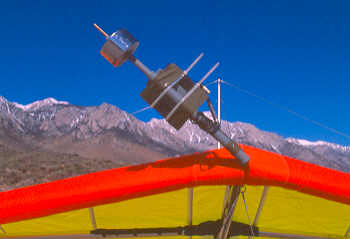
I did some tests in which I ran into strong wind on level ground near launch just to get flying for short hops. I would flare and land before actually launching off the cliff. It seemed to fly straight, but I decided it was structurally unsound. I was unsure of what a few Gs would do to the bow in the keel, and I was unwilling to find out in the real world. I elected to make a more rigid keel.
During these tests I had the rear weights on a bolt threaded into a ball head. I did not notice that the bolt was backing out. On one run the rear weights fell off! Of course with 35 pounds at the nose and nothing at the rear, the nose SLAMMED on the ground. The Torrey regulars who had been watching my experiments, and thought I was crazy anyway were now convinced I was absolutely insane. Of course during flight tests I had a back-up system to prevent any unauthorized departures.
The new 1 7/8” keel stayed straight during the full dead- weight testing. Jack Tankard and Steve Ford came to Torrey Pines to determine if and how the camera would work with the new mounting system. Without Steve I would not have done nearly as many test flights that day. He was indefatigable in carrying the 150-pound glider down to launch after I would land and make changes.
I approached this problem by the method of making small increases in weight to avoid big surprises. A cautious attitude and a logical process had lead me to the final flights with dead weights equaling full camera weight without mishap. At this point I knew it could be done. The next step would be aero-towing and no wind landings.
The hang glider / ultra-light group rendezvoused at Lone Pine two days before the film crew to get set up and practice towing. “Hungary” Joe Szalai and Cindy Benti with their daughter Catlin brought their Dragonfly. Joey Fresquez and his friend Chris Romero brought Joey’s Mustang-winged home-built Juan Corral-designed trike. Joey and Chris were traveling in Joey’s finely-tuned van. John and Jeri Dunham brought their motor-home down from Reno and Howard and Michelle Hall drove in from San Diego. I was living at the “Volkswagen Hotel” at the time.

“Hungary” Joe and Joey Fresquez performed the aero-tow function and they performed it well. Joey, an avid hang gliding enthusiast is a well-rounded pilot. He is a solid aero-tug pilot with some notable flights on rigid wings. “Hungary” Joe is the aero-tug master. He spreads the aero- tow enlightenment far and wide, and teaches students as a tandem instructor for Windsports. Cindy Benti conducted aero-tow launch operations and Chris Romera provided ground support. Catlin rode on the launch cart whenever possible.
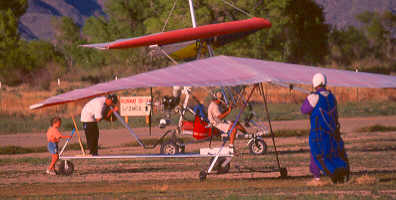 |
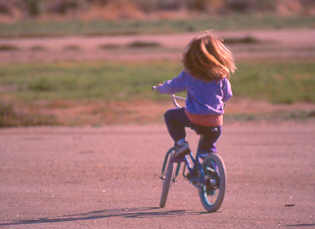 |
Both tugs endured the five-day shoot without significant problems. We towed out of Lone Pine Airport, which has a field elevation of 3700 feet. The highest tows were to about 8000 feet, which Joe had predicted would be the service ceiling of the tugs under tow.
This, our second day on location turned out to be about the last day in a period of many weeks of strong wind. Months earlier MacGillivray Freeman Films had scheduled five days for our shoot. For the last four days we had essentially clear skies and light winds for our operations. The day we left the skies turned cloudy and the strong wind returned to the valley.
After assembling their tugs, Joe and Joey made some practice tows with Howard and John. We started early in the morning for the smoothest air. I had not towed the T-2 so I set up a “V” bridle. Generally a single surface wing needs a “V” bridle to reduce pitch pressure. I took off to the south behind Joey in light wind. I found I had to push out (a lot) to get off the cart. It turns out that the T-2 is light enough in pitch pressure that it needs no “V” bridle for aero towing. I had to hold the bar way out to climb. For the next flight I used a harness-only release connection and it was great.
I was eager to try a tow with the dead weight in the camera position. This is the next logical step before trying a no- wind landing with the W-14 in this vulnerable position. The camera would be so low that it would hit the ground well before the stinger during a flare. I made an elbow to turn the keel stinger downward so it would contact the ground just before the camera. This was not going to make landing any easier, but it should help protect the camera. I had also fashioned a skid plate to further protect the bottom of the W-14.
My first tow with full dead weights (eighty pounds of steel) was uneventful. I had modified the launch carts to eliminate any chance of snagging the rear keel support with the camera or mount upon lift-off. I had survived that mistake years earlier. At 8:15 AM I towed up to about 200 feet and released. The wind had picked up to 15 out of the north and it was rowdy. I struggled to keep the wings level on landing and was denied the no-wind landing practice. I felt ready to fly with the W-14, but only in smooth air.
Howard, John and I met to discuss the hazards of flying with a helicopter. I showed them an FAA film that shows a helicopter with smoke generators defining the dramatic vortices produced by the rotor. There is a specific airspeed above which the wake turbulence of a helicopter behaves like that of a fixed-wing craft. It is called translational speed and it is around 17 mph.
Close under a hovering “helo” the air seems to take the shape of a vortex ring. You can see this if you observe a landing on dusty ground. I am sure that ground effect plays a role in this. High above the ground the hover wake might look much different. I once crossed thirty feet directly under a Bell Jet-Ranger flying above translational speed for a Tyler-mount IMAX shot and felt no turbulence.
My essential advice is that it is OK to fly above, below and to the sides of a helicopter that is moving forward at or above translational speed. In front is OK too, but do not get run over. Behind and below (or directly below during hover) are where the problems can occur. Generally the camera is shooting forward to laterally, so the pilot should have no reason to put you behind him. Ultimately, of course it is the responsibility of any pilot to be aware of and avoid potential hazards. The only evasive maneuver you can really depend on with a hang glider is the dive. When in doubt, drop the nose.
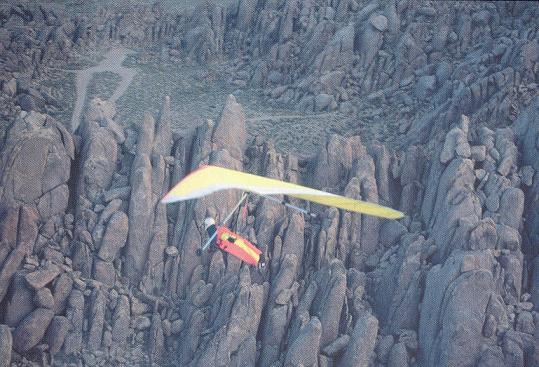 |
Howard Hall Flying his Fusion while Ron and Jim are filming from the SpaceCam-equiped helicopter. I shot this image from the back seat of the helo through some dirty plexiglass. |
While filming close to terrain, you and the helicopter pilot must have prior agreement on what each of you will and will not do. If you do not you are taking a big risk. It can get risky anyway, so talk before the flights, have perfect radio communication and always have an “out”.
I met Howard Hall a number of years ago at Torrey Pines. I believe Pork Roecker introduced us knowing that we both like cameras. Howard and wife Michele are twenty some years into a career that most of us can only envy. They are natural history film producers specializing in marine wildlife films. Howard has received six cinematography Emmys for films produced for television. Michele has received one Emmy.
Their list of films and TV programs is too long to repeat here. They are so prolific that we have all seen their work. “Coral Reef Adventure” profiles Howard and Michele Hall. Howard is director of underwater photography and Michele is line producer for “Coral Reef Adventure”. The underwater shooting was done in Fiji, Tahiti and Australia.
Howard holds a degree in zoology from San Diego State University. He is a “Roving Editor” for INTERNATIONAL WILDLIFE Magazine and a Contributing Editor for OCEAN REALM Magazine. Howard has been perfecting the art of “dive-wrestling” with IMAX cameras since 1994. When it comes to underwater cinematography, Howard Hall is the Man!
You might wonder how Owens Valley relates to coral reefs in the South Pacific. IMAX is a format that demands panoramic views. It would be a shame to shoot this fabulous wide format film without big scenics. The Owens Valley / Seirra Nevada area is one of those special places on the planet of vast beauty. The producer chose Owens Valley for the hang gliding segment for this reason and for one other. When asked to name his favorite place to fly, Howard replied “Owens Valley”.
I learned something about the producer when I cautioned him that the camera would be in jeopardy. When Greg MacGillivray wants a shot, he is willing to risk the camera to get it. I was not willing to risk the camera. My goal was to come out of this project with a good reputation. Smashing a hand-made, one-off camera (estimated replacement cost: $150,000) into the ground would not help me toward that goal.
Greg MacGillivray did not know me and had never seen me fly. He knew there was a real possibility that I would break his camera. He did not hesitate. He wanted the shot.
The producer wanted shots of Howard and John launching at Walt’s Point, thermaling up, flying along the Sierras and making their landing approaches in the Alabama Hills area. My “mount” shots would superimpose some of these. I was relieved to hear I would not need to foot-launch at Walt’s Point with my corpulent contraption.
Each shoot day Joe and Joey would tow Howard and John about five miles to the Alabama Hills so Jim Gavin, Ron Goodman and Jack Tankard could film the landings with the helo and Spacecam. After landing Howard would send his harness, flight suit and helmet back to me at the airport so I could make my tow as Howard’s “double”.
We all enjoyed the treat of early morning and late afternoon spectacular scenery and smooth air, which hang gliders rarely experience here. We usually fly in the middle of the day for the strong thermal lift. We saw beautiful morning lighting on the mountains through tears from the cold April air.
On the day of my first flight my glider was rigged with the camera, battery and counter weights. John Dunham, being an engineer was curious about the extra weight. As I prepared for my flight he walked up and said “John, I just picked up your glider and I have a whole new respect for what you are trying to do here”. It did feel unbelievably heavy.
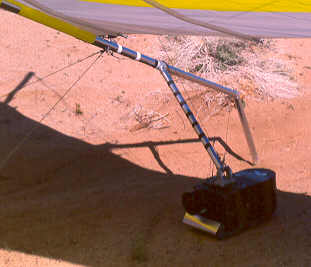
On my last fight with the W-14 I had a low-level release malfunction close to the boundary of the airport. I had to land straight-ahead just short of the motel. It was one of my best landings, but still I bent the right down tube a few inches out of column. We were striving for evening lighting, so there was no time to replace it. I quickly straightened the down tube. Hungary Joe suggested we turn around and tow down wind to save time.
I did not like that idea, but Joe pointed out that the wind had died to one mph. We towed out of there down wind, and I released high over the LZ site. I was supposed to do steep turns and wingovers on this flight. Just what I wanted to do with a bent down tube. I must have straightened it well because it held together during past 90-degree wingovers.
I restarted the camera to shoot the approach and landing. I flew between two tall rocks and over a pinnacle and had my only good landing. I switched off the camera. Jack was there within minutes. He checked the camera and informed me that the film had not run out meaning I had gotten the landing on film.
The weather was excellent for filming and Howard and John had good launch conditions. They were able to climb in thermals for the Spacecam filming despite the light lift. The wind god was smiling on this project. On the close-succession launch sequence filmed by the Spacecam, John Dunham made a bold and dutiful launch about four seconds after Howard’s. He did hit Howard’s wake, but pulled it off beautifully. I was watching from the helicopter, and he had me worried.
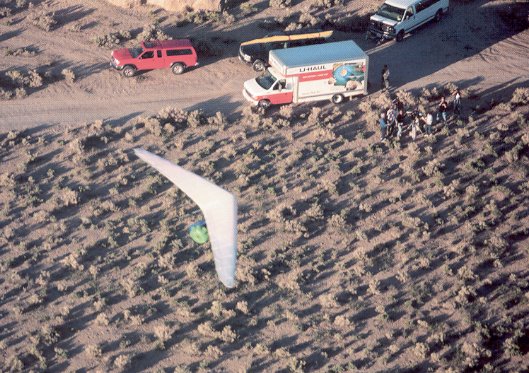
Howard and John made two or three launches off Walts Point for thermaling shots, and several tows to the Alabama Hills for the landing shots. They were certainly the first to fly Horseshoe Meadows in 2001 since they had to use a Snow Cat to get there.
Jack Tankard knows everything about operating and maintaining the IMAX cameras. He plays that crucial role of solving any camera problems that might occur. He prepared the W-14 each day for my flights, and it worked perfectly. He also rode the helicopter to work with the Spacecam operator as a shot coordinator.
Anne-Marie Hammers and production manager Cris Andrei had the hardest job of all. They had to make sure that every diverse aspect of the preparations for this major project got done on time without wasting resources. I would rather fly with two cameras than try to do that.
On my first landing I bellied in on the wheels and did not bang the camera. On my second landing I flared high over a bush, dropped the nose and tortured the down tubes. I did not bang the camera. My third landing was that aborted tow in which I bent a down tube. I did not bang the camera. By my last flight I had learned the flare timing and had a good landing.
 |
Left to right: John Heiney, Andy Synch(SpaceCam specialist), Howard Hall, Ron Goodman (SpaceCam operator), Michelle Hall, John Dumham, "Hungary" Joe Szalai(holding Catlin), Cindy Benti, Dan Dickman(Scout), Joey Fresquez(trike pilot), Greg MacGillivray(kneeling), Jim Gavin(helo pilot), Chris Romero(Joey's assistant), and Jack Tankard(IMAX camera operator) |
My small part of this project was challenging and at times intense. I found it very rewarding to work with this group of true pros, and educational to watch them do their work. The people at MacGillivray Freeman Films treated me as one of the family while working at the highest level of professionalism. Greg MacGillivray’s commitment to use his forum to promote environmental awareness makes this experience extraordinary. I feel honored to have had the opportunity to contribute to this film.
Published in February 2003 HANG GLIDING Magazine